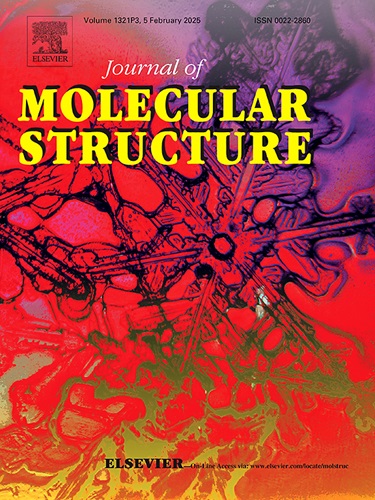Synthesis and Computational Analysis of Novel Carboximidamide/ Benzothiazole and 1,2,4-Oxadiazole/Benzothiazole Hybrid Compounds for Biological Applications
IF 4
2区 化学
Q2 CHEMISTRY, PHYSICAL
引用次数: 0
Abstract
A new series of N'-[2-(1,3-benzothiazol-2-ylthio)acetoxy]aryl-2-carboximidamides (5a-5i) and 2-([(3-aryl-1,2,4-oxadiazol-5-yl)methyl]thio)-1,3-benzothiazoles (6a-6i) were successfully synthesized in good to excellent yields by reacting (1,3-benzothiazol-2-ylthio)acetic acid (2) with the respective arylamidoximes (4a-4i). The reactions were carried out in dry polar aprotic solvents, with acetonitrile used for the synthesis of 5a-5i and dimethylformamide for 6a-6i, in the presence of N,N'-carbonyldiimidazole as a coupling reagent. The structures of the target synthesized were clearly confirmed through IR, NMR, elemental analysis, and mass spectrometry data. The electronic properties and optimized geometries of compounds 5a–6i, analyzed through DFT (Density Functional Theory), provided valuable insights into their reactivity and interaction potential with biological targets. Analysis of the HOMO and LUMO highlighted regions of nucleophilic and electrophilic interactions, which are influenced by the presence of electron-donating and withdrawing substituents. These electronic factors correlate directly with the predicted biological activities of the compounds. Notably, compounds 5 g and 6 g emerged as the most promising candidates for biological applications, displaying narrow energy gaps, high electrophilicity indices, and balanced chemical hardness, indicating the importance of tuning electronic properties to optimize biological efficacy.
新型碳西米酰胺/苯并噻唑和1,2,4-恶二唑/苯并噻唑生物杂化化合物的合成与计算分析
通过(1,3-苯并噻唑-2-基噻唑)乙酸(2)与相应的芳基酰胺(4a-4i)反应,成功合成了N′-[2-(1,3-苯并噻唑-2-基噻唑)乙酰氧基]芳基-2-碳酰胺(5a-5i)和2-([(3-芳基-1,2,4-恶二唑-5-基)甲基]噻唑)-1,3-苯并噻唑(6a-6i)。反应在干极性非质子溶剂中进行,以乙腈合成5a-5i,以二甲基甲酰胺合成6a-6i,偶联剂N,N'-羰基二咪唑存在。通过红外光谱、核磁共振光谱、元素分析和质谱分析,明确了合成目标物的结构。通过DFT(密度泛函理论)分析化合物5a-6i的电子性质和优化的几何形状,为它们的反应性和与生物靶标的相互作用潜力提供了有价值的见解。HOMO和LUMO的分析突出了亲核和亲电相互作用区域,这些区域受到供电子和吸电子取代基的影响。这些电子因子与化合物预测的生物活性直接相关。值得注意的是,化合物5 g和6 g表现出窄的能隙、高的亲电性指数和平衡的化学硬度,成为最有希望应用于生物领域的候选者,这表明调整电子性质对优化生物功效的重要性。
本文章由计算机程序翻译,如有差异,请以英文原文为准。
求助全文
约1分钟内获得全文
求助全文
来源期刊

Journal of Molecular Structure
化学-物理化学
CiteScore
7.10
自引率
15.80%
发文量
2384
审稿时长
45 days
期刊介绍:
The Journal of Molecular Structure is dedicated to the publication of full-length articles and review papers, providing important new structural information on all types of chemical species including:
• Stable and unstable molecules in all types of environments (vapour, molecular beam, liquid, solution, liquid crystal, solid state, matrix-isolated, surface-absorbed etc.)
• Chemical intermediates
• Molecules in excited states
• Biological molecules
• Polymers.
The methods used may include any combination of spectroscopic and non-spectroscopic techniques, for example:
• Infrared spectroscopy (mid, far, near)
• Raman spectroscopy and non-linear Raman methods (CARS, etc.)
• Electronic absorption spectroscopy
• Optical rotatory dispersion and circular dichroism
• Fluorescence and phosphorescence techniques
• Electron spectroscopies (PES, XPS), EXAFS, etc.
• Microwave spectroscopy
• Electron diffraction
• NMR and ESR spectroscopies
• Mössbauer spectroscopy
• X-ray crystallography
• Charge Density Analyses
• Computational Studies (supplementing experimental methods)
We encourage publications combining theoretical and experimental approaches. The structural insights gained by the studies should be correlated with the properties, activity and/ or reactivity of the molecule under investigation and the relevance of this molecule and its implications should be discussed.
 求助内容:
求助内容: 应助结果提醒方式:
应助结果提醒方式:


